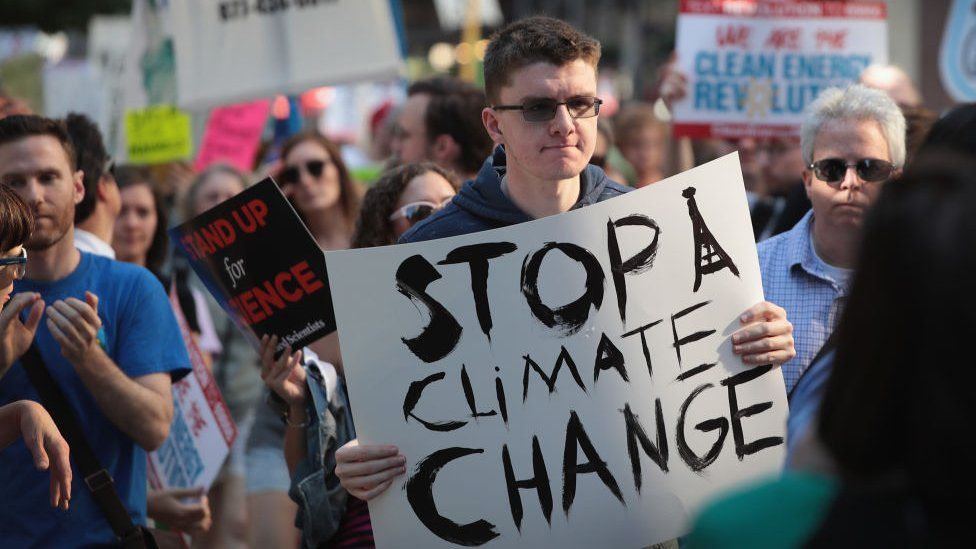What is the Paris climate agreement and why does 1.5C matter?
- Published

For the first time, global warming has exceeded 1.5C across an entire year, according to the EU's climate service.
Keeping long-term temperature increases below this level is seen as crucial if the most damaging impacts of climate change are to be avoided.
What is the Paris Agreement?
In 2015, world leaders pledged to try and prevent global temperatures rising by more than 1.5C.
It saw almost all the world's nations - for the first time - agree to cut the greenhouse gas emissions which cause global warming.
Adopted by 194 parties (193 countries plus the EU) in the French capital on 12 December 2015, the Paris Agreement came into force on 4 November 2016.
What did the Paris Agreement say?
The agreement lists a series of commitments:
- To "pursue efforts" to limit global temperature rises to 1.5C, and to keep them "well below" 2.0C above those recorded in pre-industrial times
- To limit greenhouse gas emissions from human activity to the same levels that trees, soil and oceans can absorb naturally - known as net zero - between 2050 and 2100
- Each country to set its own emission-reduction targets, reviewed every five years to raise ambitions
- Richer countries to help poorer nations by providing funding, known as climate finance, to adapt to climate change and switch to renewable energy
The 1.5C target is generally accepted to mean a 20 year average, rather than a single year.
Why does keeping global warming to 1.5C matter?
Scientists say that every 0.1C of temperature increase brings with it greater risks for the planet - longer heatwaves, more intense storms and wildfires.
The 1.5C target was agreed because there is very strong evidence that the impacts would become much more extreme as the world gets closer to 2C. Some changes could become irreversible.
The science is not completely certain, but the consequences of 2C global warming versus 1.5C could be:
- Extreme hot days would be on average 4C warmer at mid-latitudes (regions outside the poles and tropics), versus 3C at 1.5C
- Sea-level rise would be 0.1m higher than at 1.5C, exposing up to 10 million more people to more frequent flooding
- More than 99% of coral reefs would be lost, compared with 70-90% at 1.5C
What have countries done since the Paris Agreement?
World leaders meet every year to discuss their climate commitments, at international summits known as COPs (Conference of the Parties).
All COPs since 2015 have tracked how countries are building on what they promised in Paris.
When the agreement was signed, governments admitted the Paris targets would not limit global warming to 1.5C.
Current pledges and targets still put the world on track for around 2.1C of warming by 2100, according to the independent Climate Action Tracker.
The UK has a legally binding commitment to reduce emissions by 68% by 2030 compared to 1990 levels. But in September 2023, Prime Minister Rishi Sunak announced delays to several green policies, such as delaying the phase-out of new petrol and diesel cars.
The UK government's independent climate advisers warned that the announcements were "likely to take the UK further away from being able to meet its legal commitments".
At the most recent COP28 in December 2023, for the first time countries agreed to "contribute" to "transitioning away from fossil fuels", although they are not forced to take action.
Analysis for COP28 by the UN made clear that further "deep, rapid and sustained reductions" in greenhouse gas emissions were needed to prevent the permanent breach of 1.5C.
What did the Paris agreement promise for poorer countries?
The Paris deal restated a commitment first made in 2009 that the world's richer countries should provide $100bn (£79bn) annually by 2020 to help developing nations deal with the effects of climate change, and build greener economies.
In 2020 only $83.3bn was raised, but the OECD said it thinks the 2022 figures will show the goal "is likely to have been met".
For decades developing countries have also been demanding payments for "loss and damage". This is compensation to cover the effects of climate change which they are already experiencing.
Little progress was made until COP28, where delegates agreed to launch the fund. The EU, UK, US and others announced contributions totalling around $700m (£556m).